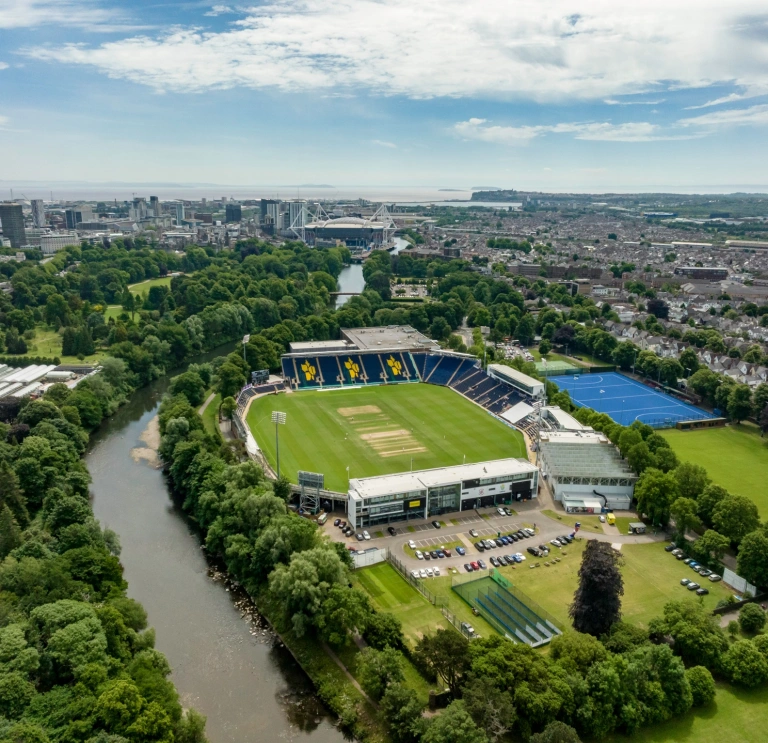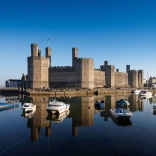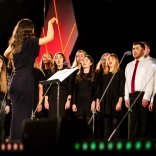What does the Australian cricketer Marnus Labuschagne have in common with Jimi Hendrix, Pink Floyd and Fleetwood Mac? Answer: they’ve all played at Sophia Gardens, a beautiful riverside spot nestled among towering trees, just outside Cardiff city centre.
It has been a recreational spot for centuries, Buffalo Bill’s Wild West Show swung by in 1891 - but in modern times it’s the sport of cricket that provides the big hits and derring-do.
Glamorgan County Cricket Club moved from its original Cardiff Arms Park base, in the late 1960s. Since then, Sophia Gardens has grown into a 16,000-seater stadium with world-class facilities for gigs and events, on top of all the cricket action. It staged sold-out Ashes Test matches in 2009 and 2015, and continues to host One Day and T20 Internationals, as well as major international tournaments.
Cricket is thriving in Wales. Big crowds regularly turn out to watch Glamorgan play, and thrilling new formats are attracting new cohorts of fans. For example, in The Hundred competition – a breathless 100-ball smash – the women’s and men’s Welsh Fire teams play double-headers at Sophia Gardens.

It’s also the home of the National Cricket Centre and Cricket Wales, who nurture grassroots cricket through schemes like All-Stars and Dynamos for younger kids, as well as programmes for disadvantaged kids, and for people with disabilities.
The women’s game, especially, is booming. Women and girls all over Wales are taking up the sport recreationally, and there’ll be a professional standard girls’ pathway in place from 2025, and a Glamorgan Women’s professional team in 2027.
It’s the latest chapter in the story of cricket in Wales, which goes back almost as far as the invention of the sport itself.
Throughout history, every human civilisation has played games that involve whacking something with a stick. But none is more steeped in ritual, tradition and unusual apparel – or more gloriously baffling to outsiders – than the noble game of cricket.


We have the English to thank for this beautiful madness. They formally codified the laws of cricket in the mid-1700s, and the game began to spread around the world. It’s no coincidence that the sport’s modern powerhouses are in places where the British Empire left its boot print: Australia, New Zealand, Pakistan, India, South Africa, the West Indies, Sri Lanka, Zimbabwe, Bangladesh, Afghanistan and Ireland. The game is also firmly established in over 100 other countries around the world, from Finland to Bhutan.
But cricket’s first stop was England’s nearest neighbour: Wales.
Cricket was first mentioned here in 1771, when an angry gentleman in Swansea wrote to his local newspaper to complain about “… the swearing and use of oaths used by young men and boys playing cricket in the town on the Sabbath”. The earliest recorded example of sledging, perhaps?
The first known match took place in 1783 in Carmarthenshire, where two teams of gentlemen took to the field to uphold the honour of their estates on opposing sides of the River Cothi.
In the early days, cricket was often played as part of annual summer festivals, or as a prelude to grand banquets. The game gradually spread down the social ladder, through the gentry and public school system, and into the working classes of Wales.

It fitted the popular 19th century ethic of ‘Muscular Christianity’, when cricket was seen as a healthy pursuit for young chaps, who might otherwise be up to less wholesome activities. The game was also championed by the industrial barons, who set up cricket clubs to represent their factories and collieries. Cricket was a means of ensuring a healthier, more productive and sober workforce.
By the mid-19th century, there were flourishing cricket clubs in towns and villages throughout Wales. The South Wales Cricket Club was formed in 1859, becoming our first fully fledged regional team. At around the same time, the laws of rugby union and football were being codified. New sports teams, playing newly invented sports, sprang from the cricket clubs as something to do in the winter months.
The biggest leap forward was the foundation of Glamorgan County Cricket Club in 1888. Glamorgan became – and remains – the powerful engine at the heart of Welsh cricket, rubbing shoulders with the best in first-class cricket. Then the England and Wales Cricket Board (ECB) was established on 1 January 1997 as the single national governing body for all cricket in England and Wales.
In 1930, Glamorgan’s captain, Maurice Turnbull, became the club’s first Test player; he remains the only man to have played rugby for Wales and cricket for England. Wilf Wooller, another Welsh rugby star, captained Glamorgan to their first county title in 1948.
From the 1960s, some of the world’s great players have represented the club. Pakistan’s Javed Miandad and India’s Ravi Shastri were dynamic batters in the 1980s. Glamorgan won the Sunday League in 1993 with the West Indian legend Sir Viv Richards, while in 1997, Pakistani fast bowler Waqar Younis played a leading role in another Championship title. Most recently, the Australian batter Marnus Labuschagne has become a fan favourite at Sophia Gardens.
What began as an eccentric amusement for the gentry has become a powerful force for inclusion and diversity in modern Wales, both for players and spectators.
With thanks to the Museum of Welsh Cricket at Sophia Gardens, Cardiff. For match information and more, see Glamorgan CCC.



